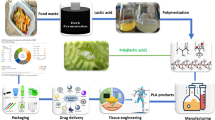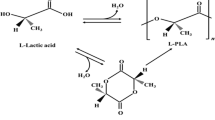Abstract
A series of polyhydroxyalkanoates (PHA), all containing 1% nucleating agent but varying in structure, were melt-processed into films through single screw extrusion techniques. This series consisted of three polyhydroxybutyrate (PHB) and three polyhydroxybutyrate-valerate (PHBV) resins with varying valerate content. Processing parameters of temperature in the barrel (165–173 °C) and chill rolls (60 °C) were optimized to obtain cast films. The gel-permeation chromatography (GPC) results showed a loss of 8–19% of the polymer’s initial molecular weight due to extrusion processing. Modulated differential scanning calorimetry (MDSC) displayed glass transition temperatures of the films ranging from −4.6 to 6.7 °C depending on the amount of crystallinity in the film. DSC data were also used to calculate the percent crystallinity of each sample and slightly higher crystallinity was observed in the PHBV series of samples. X-ray diffraction patterns did not vary significantly for any of the samples and crystallinity was confirmed with X-ray data. Dynamic mechanical analysis (DMA) verified the glass transition trends for the films from DSC while loss modulus (E′) reported at 20 °C showed that the PHBV (3,950–3,600 MPa) had the higher E′ values than the PHB (3,500–2,698 MPa) samples. The Young’s modulus values of the PHB and PHBV samples ranged from 700 to 900 MPa and 900 to 1,500 MPa, respectively. Polarized light microscopy images revealed gel particles in the films processed through single-screw extrusion, which may have caused diminished Young’s modulus and tensile strength of these films. The PHBV film samples exhibited the greatest barrier properties to oxygen and water vapor when compared to the PHB film samples. The average oxygen transmission rate (OTR) and water vapor transmission rate (WVTR) for the PHBV samples was 247 (cc-mil/m2-day) and 118 (g-mil/m2-day), respectively; while the average OTR and WVTR for the PHB samples was 350 (cc-mil/m2-day) and 178 (g-mil/m2-day), respectively. Biodegradation data of the films in the marine environment demonstrated that all PHA film samples achieved a minimum of 70% mineralization in 40 days when run in accordance with ASTM 6691. For static and dynamic incubation experiments in seawater, microbial action resulting in weight loss as a function of time showed all samples to be highly biodegradable and correlated with the ASTM 6691 biodegradation data.









Similar content being viewed by others
References
Volova TG, Nekrasov YP, Shishashkaya EI, Puzyr AP, Gordeev SA (2003) Plasticheskie Massy 3:6–8
Gorenflo V, Schmack G, Vogel R, Steinbuechel A (2001) Biomacromolecules 2(1):45–47
Philip S, Keshavarz T, Roy I (2007) J Chem Technol Biotechnol 82(3):233–247
Hassan M, Abou-Hussein R, Zhang X, Mark J, Noda I (2006) Mol Cryst Liquid Cryst 447:341–362
Satkowski MN, Melik DH, Autran JP, Green PR, Noda I, Schechtman LA (2001) Biopolymers 3b:231–263
Wang Y-W, Mo W, Yao H, Wu Q, Chen J, Chen G-Q (2004) Polym Degrad Stab 85:815–821
Gao Y, Kong L, Zhang L, Gong Y, Chen G, Zhao N, Zhang X (2006) Euro Polym J 42:764–775
Volova TG, Nekrasov YP, Shishatskaya E, Puzyr A, Gordeev S (2003) Intl Polym Sci Technol 30:9–13
Doi Y (1990) Microbial polyesters. VCH Publishers Inc., New York
Holmes PA (1988) In: Bassett DC (ed) Developments in crystalline polymers—2. Elsevier, London
LaTuga B, Ramirez S, Arceo J, Flythe M, Rowe S, Baron S, Dennis D, Augustine B (2003) Polym Mater Sci Eng 88:277–278
Jendrossek D, Schirmer A, Schlegel H (1996) Appl Microbiol Biotechnol 46:451–463
Doi Y, Kanesawa Y, Tanahashi N, Kumagal Y (1992) Polym Degrad Stab 36:173
Madison L, Huisman G (1999) Microbiol Mol Biol Rev 63:21–53
Sridewi N, Bhubalan K, Sudesh K (2006) Polym Degrad Stab 91(12):2931–2940
Song C, Wang S, Ono S, Zhang B, Shimasaki C, Inoue M (2003) Polym Adv Technol 14(2–5):184–188
Gao H, Chen J, Du G, Wu Y, Lun S (1997) Zhongguo Huanjing Kexue 17(4):330–334
Rizzarelli P, Puglisi C, Montaudo G (2004) Polym Degrad Stab 85:855–863
Volova T, Gladyshev M, Trusova M, Zhila N, Kartushinskaya M (2004) Proc Acad Sci USSR Doklady Biol Sci 397:330–332
Renard E, Walls M, Guerin P, Langlois V (2004) Polym Degrad Stab 85:779–787
DaSilva MG, Marcelo G, Vargas H, Poley LH, Rodriguez RS, Baptista GB (2005) J Brazil Chem Soc 16(4):790–795
Zhao K, Deng Y, Chen J, Chen G-Q (2003) Biomaterials 24:1041–1045
Fuguly GD (2002) Processing of polyhydroxyalkanoates using a nucleant and a plasticizer, compositions and articles. PCT Int Appl, WO 2002085983
Asrar J, D’Haene P (1999) Modified polyhydroxyalkanoates for production of coatings and films, PCT Int Appl WO 9914268
Asrar J, Pierre JR (1999) Polyhydroxyalkanoate compositions and their use in the production of films, PCT Int Appl WO 9905207
Waddington SD (1994) Polyhydroxyalkanoates and film formation therefrom, PCT Int Appl WE 9416000
Iwata T, Doi Y (2003) High-strength film of polyhydroxyalkanoic acid and process for producing the same, PCT Int Appl WO 2003070450
Bastioli C, Del Tredici G, Guanella I (2005) Process for production of biodegradable films having improved mechanical properties, PCT Int Appl, WO 2005120808
Figuly G (2003) Processing of polyhydroxyalkanoates using a nucleant and a plasticizer, US Pat Appl Publ, US 2003181555
Ho Y-H, Gan S-N, Tan I (2002) Appl Biochem Biotechnol 102–103:337–347
Ratto J, Thellen C, Froio D, Wirsen C (2006) Biodegradation studies of polyhydroxyalkanoate films in the marine environment. International degradable plastics symposium. Poster P-9, Chicago, IL
Acknowledgments
The authors acknowledge Robert Whitehouse, Allen Padwa and Mirel Sharxhi of Metabolix for the materials as well as their assistance and advice on modulated DSC and DMA experiments. The authors also acknowledge Professor Steven Orroth at the University of Massachusetts Lowell for the use of the single screw extruder. The authors thank the U.S. Navy’s Waste Reduction Afloat Protects the Sea (WRAPS) Program for supporting this research.
Author information
Authors and Affiliations
Corresponding author
Rights and permissions
About this article
Cite this article
Thellen, C., Coyne, M., Froio, D. et al. A Processing, Characterization and Marine Biodegradation Study of Melt-Extruded Polyhydroxyalkanoate (PHA) Films. J Polym Environ 16, 1–11 (2008). https://doi.org/10.1007/s10924-008-0079-6
Published:
Issue Date:
DOI: https://doi.org/10.1007/s10924-008-0079-6




